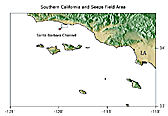Welcome to the UCSB Hydrocarbon Seeps web site
 For
thousands of years, oil and natural gas have erupted from natural marine
hydrocarbon seeps in the depths of the Santa Barbara Channel. The seeps
have a long local history. Tar deposits on the beaches were used by the
native Californians and led to the onset of offshore petroleum exploration
in the Channel and around the world. The seeps now serve as a area to
study contributions from natural seeps to the sea, land, and Earth's atmosphere.
For
thousands of years, oil and natural gas have erupted from natural marine
hydrocarbon seeps in the depths of the Santa Barbara Channel. The seeps
have a long local history. Tar deposits on the beaches were used by the
native Californians and led to the onset of offshore petroleum exploration
in the Channel and around the world. The seeps now serve as a area to
study contributions from natural seeps to the sea, land, and Earth's atmosphere.
Our study area is located offshore of Coal Oil Point, California (see map).
This project
has the primary goal of estimating seep emissions and revealing their effects. In particular,
we seek to understand the following emission types: (1) natural gas to the
atmosphere, (2) oil to the sea surface, (3) dissolved hydrocarbons in seawater.
(see Project Objectives)
Methods employed include sonar 3.5 kHz profiling and side scan surveys, gas capture, dissolved gas sampling/analysis, tar sampling/analysis, and geological investigations.
This site is maintained by the UCSB Department of Earth Science, and represents research done within the Department and includes contributions from the UCSB Institute for Crustal Studies, the UCSB Institute for Computational Earth Systems Science, and the UCSB Marine Science Institute. A companion site created by Dr. Ira Leifer with expanded content can be accessed here - Bubbleology (see "Marine Seeps").
March 2007
For comments or suggestions on our web page, please contact: (include subject word "seeps") Thor Egland